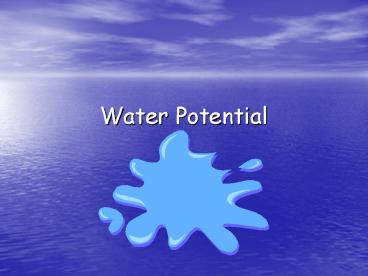Water Potential - PowerPoint PPT Presentation
1 / 20
Title:
Water Potential
Description:
Water Potential Water potential Tendency of a solution to take up water Tendency of water to diffuse from one area to another (psi) Water potential Two components to ... – PowerPoint PPT presentation
Number of Views:688
Avg rating:3.0/5.0
Title: Water Potential
1
Water Potential
2
(No Transcript)
3
Water potential
- Tendency of a solution to take up water
- Tendency of water to diffuse from one area to
another - ? (psi)
4
Water potential
- Two components to water potential
- 1. Pressure
- Physical forces, can be positive or negative
- If positive increased pressure.
- If negative decreased pressure.
- 2. Solute concentration (or osmotic potential)
- Always negative
5
Water potential
- Water potential of a solution is the sum
- Solute potential ?s (osmotic potential)
- Pressure potential ?p
- Water potential is expressed as
- ? ?s ?p
6
Water potential
- Pure water ?0
- Adding solute lowers potential
- Less free water molecules
- Water moves from a higher water potential to a
lower water potential - Less concentrated (hypotonic) to a more
concentrated (hypertonic)
7
Animal cells
- Water movement depends only on solute
concentrations. - Hypertonic solution the water moves out and the
cell shrinks - Hypotonic solution the water moves in and the
cell swells - Bursting (Lysis) can happen.
8
Animal cell
9
Plant cells
- Cell wall can exert pressure and prevents lysis.
- When the pressure inside the cell becomes large
enough - No additional water can enter the cell
- Even if the cell still has a higher solute
concentration.
10
Plant cells
- Flaccid
- Limp-lost water
- Turgid
- Firm-gained water
- Plasmolysis
- Plant cell shrinks from cell wall
- Lost water
11
Plant cell
12
Lab
13
Fig. 7-UN3
Environment 0.01 M sucrose 0.01 M glucose 0.01 M
fructose
Cell
0.03 M sucrose 0.02 M glucose
14
Fig. 36-8a
(a)
0.1 Msolution
Purewater
H2O
?P 0?S -0.23
?P 0?S 0
? -0.23 MPa
? 0 MPa
15
Fig. 36-8b
(b)
Positivepressure
H2O
?P 0.23?S -0.23
?P 0?S 0
? 0 MPa
? 0 MPa
16
Fig. 36-8c
(c)
Increasedpositivepressure
H2O
?P ?S -0.23
?P 0?S 0
0.30
? 0.07 MPa
? 0 MPa
17
Fig. 36-9a
Initial flaccid cell
?P 0?S -0.7
0.4 M sucrose solution
? -0.7 MPa
?P 0 ?S -0.9
? -0.9 MPa
Plasmolyzed cell
?P 0 ?S -0.9
? -0.9 MPa
(a) Initial conditions cellular ? gt
environmental ?
18
Fig. 36-9b
Initial flaccid cell
?P 0?S -0.7
Pure water
? -0.7 MPa
?P 0?S 0
? 0 MPa
Turgid cell
?P 0.7?S -0.7
? 0 MPa
(b) Initial conditions cellular ? lt
environmental ?
19
(No Transcript)
20
- ?s -iCRT
- i ionization constant (for sucrose this is 1.0
because sucrose does not ionize water) - C Molar concentration (from experiment)
- R Pressure constant (R0.0831 liter bars/mole
K) - T temperature in K (273 C)

